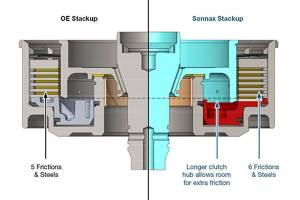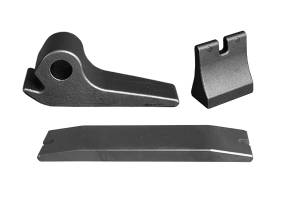35-Spline Input Shaft & Triple Disc Torque Converter Kit
Chrysler 47RE | 48RE
California Residents: Prop 65 Warning
WARNING: Cancer and Reproductive Harm
Visit: www.p65warnings.ca.gov
Description
Goerend Difference:
- Designed and manufactured in-house from start to finish
- K-factor and torque ratio tested on in-house dynamometer
- Billet steel cover
- Made from steel forgings to reduce porosity
- Multi-bolt pattern
- Billet steel piston with complete damper assembly
- Insulates shock of crank pulses from rest of driveline
- Extends life of converter and transmission
- Made from steel forgings to reduce porosity
- Stator guaranteed to never break
- Designed to rotate better when going into coupling mode
- Creates a venturi effect to help torque multiplication
- Dual Torrington bearing stator design
- Lugged stator races
- Patented internal design
- Insures lock up on computer and valve body signal
- Eliminates need to feather throttle to reach lock up
- Patented fluid flow deflector
- Proprietary high-performance multi-disc lock up clutches
- TIG welded, furnace brazed, and silicon bronze reinforced turbine
- Below 0.005 blueprinted runout tolerances
- Blueprinted internal clearances
- Fully pressurized and leak tested
- Computerized robotic welding
- 4140 hardened turbine hub
- 4140 flanged impeller hub
- Accurately designed pilot
- Computerized balancing
Sonnax Big Input Shaft Kit
The Sonnax Smart-Tech big input shaft kit 22121B-08K is the ultimate solution to prevent input shaft spline-twist and breakage in high torque Chrysler 47RH, 47RE and 48RE diesel applications. Compared to the best 300M 23-spline shafts, the Sonnax input shaft is 35% stronger at both the spline portion of the shaft and the sealing ring/cross-hole area of the shaft, eliminating all concerns of failure at these critical points.
The larger sealing ring and cross-hole area requires a custom stator/pump cover assembly. The stator assembly features standard 48RE tube splines made of high-strength steel, improved retention in stator body, 48RE matched pump porting and special rubber seals to eliminate oil leakage between cover and pump body.
The longer direct (front) clutch hub portion of the shaft has longer splines that allows for one extra (OE-thickness) direct friction plate when used with included thinner billet aluminum direct piston, all while keeping OE-thickness steels, backing plate, OE waved retaining ring and OE clutch clearances.
Some common aftermarket modifications designed to include extra clutches require reduced steel thickness and decrease the heat absorption capacity of the clutch pack, others reduce clearance and eliminate the waved retaining ring, which contributes to excess 2-3 shift overlap. The Sonnax kit avoids these problems by increasing the number of frictions from five to six, adding to the steel mass of the clutch pack and maintaining the OE thickness backing plate and clearances for the optimum combination of increased capacity and durability.
- Extreme duty, 1-1/8” diameter 35-spline input shaft
- .100” larger diameter at sealing ring cross hole area
- One-piece shaft forged from ultra-high strength 300M billet steel eliminates weak connection between shaft and clutch hub
- Keeps OE oil flow areas and eliminates leakage for predictable, trouble-free lockup, release and apply
- Custom stator assembly optimizes performance and long-term durability
Articles
- Rowdy, Single Turbo, 48RE-Swapped '05 Dodge
- Orange Crush
- Clean Sheet
- Bulletproof Your Dodge Transmission
- 1,500 HP '18 Ram
- Must-Have Parts For Upgrading Your Truck's Transmission
- Turbocharged 5.9L 12-Valve Cummins Engine
Limited Lifetime Warranty:
Limited Lifetime Warranty is specifically limited to the torque converter purchased from Goerend. Warranty applies to any potential manufacturing defect inside the torque converter. Warranty does not cover any outside influences on the torque converter, or OEM stators. Warranty does not include loss of time, use, towing, installation, freight, or per diem damages. To transfer the warranty, invoice must be provided to Goerend. Warranty only valid through Goerend.














